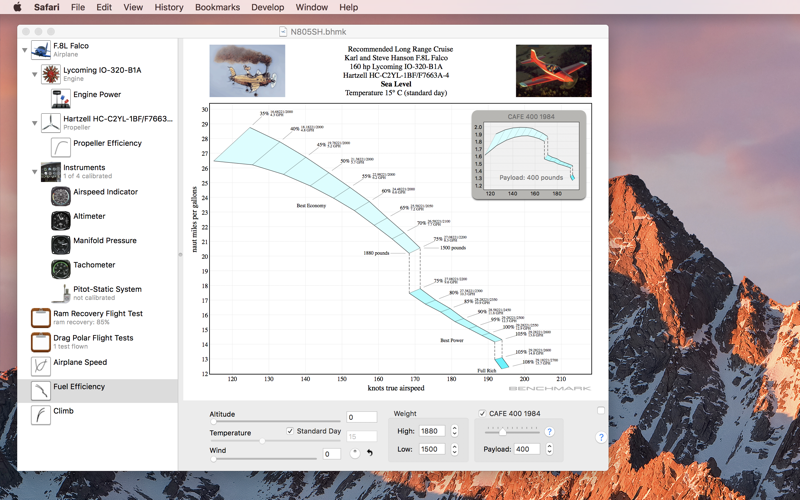
A Flight Manual for the Rest of Us
Benchmark allows you to create an interactive flight manual for a piston-engine airplane with a constant-speed propeller, single or multi-engined. It is based on a method of performance flight testing and analysis first developed by Boeing during World War II to create accurate performance flight manuals for the B17 and B29 bombers.
It was a revolution in technology, and it provided the ability to create fuel efficiency charts for a wide range of aircraft weights, payload and number of operational engines at any altitude or temperature. This method is now used by all aircraft companies. It requires accurate data on the engine power, propeller characteristics, aircraft specifications and flight performance. The data collection and flight data is very detailed and involved, and then months of work by engineers to produce the charts.
A second revolution was when Mooney under the direction of Roy LoPresti introduced Miles Per Gallon charts for the flight manuals of the Mooney 201. No one had ever seen anything like it.
Over the following years, Alfred Scott and Jim Petty developed Benchmark as a computer program to automate the entire process, beginning with a very basic program that ran on the early Mac Plus in 1990. Once the data was entered, Benchmark would do all the calculations required for engine power, propeller efficiency, airplane speed, and miles-per-gallon charts.
In 2006 Matt Emerson began working on it to make Benchmark a modern Macintosh application with an elegant interface, and since then we have added many features.
Brien Seeley at the CAFE Foundation got involved, and we produced a version of the Miles Per Gallon charts with the CAFE 400 scores. Then we included the CAFE 400 race results into the program so you could compare your performance with the contestants in each years competition.
Test pilot Norm Howell got involved and modeled his Mooney 201 in Benchmark, and we added climb charts which he developed for his masters thesis at Embry Riddle on an optimized climb speed, Vz.
We added a propeller noise calculation at the request of Brien Seeley, and he has been using this for the design of revolutionary Sky Taxi designs with large, ultra-quiet multi-bladed propellers that can operate out of pocket airports the size of a parking lot.
The irony is that the 26 years of development have gone into producing charts which are now essentially obsolete as printed documents...and the combination of Benchmark and a MacBook now becomes a flight manual for the rest of us.
After you have downloaded Benchmark, it makes sense to start with an airplane that is already modeled in Benchmark. Then change engines, propellers, or adjust the performance to match your aircraft. These are all provided at http://www.seqair.com/benchmark, along with documentation, history, engineering, articles and reviews.


